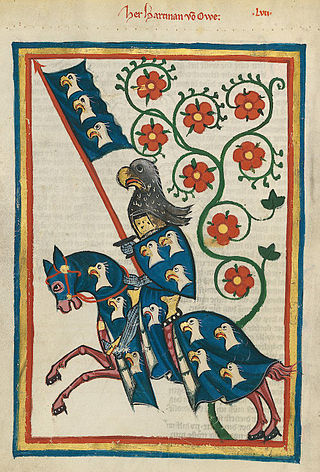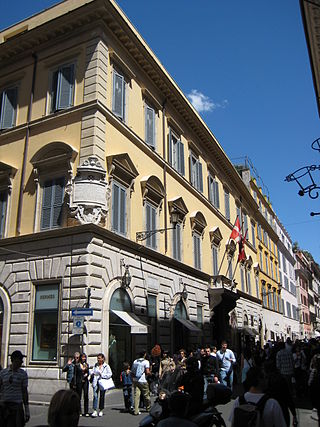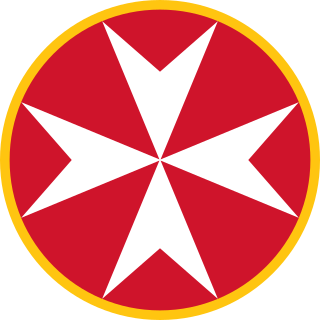
A knight is a person granted an honorary title of knighthood by a head of state or representative for service to the monarch, the church or the country, especially in a military capacity. Knighthood finds origins in the ancient Greek hippeis (ἱππεῖς) and Roman equites.

The Sovereign Military Order of Malta (SMOM), officially the Sovereign Military Hospitaller Order of Saint John of Jerusalem, of Rhodes and of Malta, commonly known as the Order of Malta or Knights of Malta, is a Catholic lay religious order, traditionally of a military, chivalric, and noble nature. Though it possesses no territory, the order is often considered a sovereign entity under international law.
The Russian tradition of the Knights Hospitaller is a collection of charitable organisations claiming continuity with the Russian Orthodox grand priory of the Order of Saint John. The order emerged when Malta was captured by Napoleon in 1798 during the expedition to Egypt. The Grand Master at the stronghold of Malta, Ferdinand von Hompesch, failed to anticipate or prepare for the threat. The Order continued to exist in a diminished form and negotiated with European governments for a return to power. The Emperor of Russia gave shelter to the largest number of Knights in St Petersburg and this gave rise to the Russian tradition of the Knights Hospitaller and recognition within the Russian Imperial Orders. In gratitude the Knights declared Ferdinand von Hompesch deposed and Emperor Paul I was elected as the new Grand Master. The continuous Order was also approved by the Papacy, but due to British fear of Russian taking presence in the Mediterranean and because many knights were Orthodox the Order became de facto the traditional Order but de jure not recognised similar or at par with the formation of the 19th-century Sovereign Military Order of Malta.

The Equestrian Order of the Holy Sepulchre of Jerusalem, also called Order of the Holy Sepulchre or Knights of the Holy Sepulchre, is a Catholic order of knighthood under the protection of the Holy See. The Pope is the sovereign of the order. The order creates canons as well as knights, with the primary mission to "support the Christian presence in the Holy Land". It is an internationally recognized order of chivalry. The order today is estimated to have some 30,000 knights and dames in 60 lieutenancies around the world. The Cardinal Grand Master has been Fernando Filoni since 2019, and the Latin Patriarch of Jerusalem is ex officio the Order's Grand Prior. Its headquarters are situated at the Palazzo Della Rovere and its official church in Sant'Onofrio al Gianicolo, both in Rome, close to Vatican City.

An order is a visible honour awarded by a sovereign state, monarch, dynastic house or organisation to a person, typically in recognition of individual merit, that often comes with distinctive insignia such as collars, medals, badges, and sashes worn by recipients.
The fount of honour is a person, who, by virtue of his or her official position, has the exclusive right of conferring legitimate titles of nobility and orders of chivalry on other persons.
A dynastic order, monarchical order, or house order is an order under royal patronage. Such an order is bestowed by, as a legitimate fons honorum, a sovereign or the head of a once-sovereign ruling family. These are often considered part of the cultural patrimony of the ruling family. Dynastic orders were often founded or maintained to reward service to a monarch or their subsequent dynasty.

An order of chivalry, order of knighthood, chivalric order, or equestrian order is an order of knights, typically founded during or inspired by the original Catholic military orders of the Crusades and paired with medieval concepts of ideals of chivalry.

Grand Master is a title of the supreme head of various orders, including chivalric orders such as military orders and dynastic orders of knighthood.
Commander, or Knight Commander, is a title of honor prevalent in chivalric orders and fraternal orders.
(George) Robert Gair, who later assumed the surname Gayre of Gayre and Nigg, was a Scottish anthropologist who founded Mankind Quarterly, a peer-reviewed academic journal which has been described as a "cornerstone of the scientific racism establishment". An authority on heraldry, he also founded The Armorial, and published a number of books on this subject. He achieved notoriety for claiming to be the Chief of "Clan Gayre" and "Clan Gayre and Nigg", it being subsequently found that such a "clan" had never existed; per the Glasgow Herald, Gayre created "a Scottish clan from scratch, providing it with traditions, rituals, precedences and privileges". Further, not only did he not have legitimate male-line Gair descent, but he had falsified a pedigree, given to Burke's Peerage among others, connecting his ancestor to a minor family of the name resident at Nigg. Many biographical details, such as ranks, degrees, and titles he claimed, are not independently verifiable, deriving from his own writings.

The Order of Knights of the Hospital of Saint John of Jerusalem, commonly known as the Knights Hospitaller, is a medieval and early modern Catholic military order. It was founded in the Kingdom of Jerusalem in the 12th century and had headquarters there until 1291, thereafter being based in Kolossi Castle in Cyprus (1302–1310), the island of Rhodes (1310–1522), Malta (1530–1798), and Saint Petersburg (1799–1801).

Palazzo Malta, officially named as the Magistral Palace, and also known as Palazzo di Malta or Palazzo dell'Ordine di Malta, is the more important of the two headquarters of the Sovereign Military Order of Malta, a Roman Catholic lay religious order and a sovereign subject of international law. It is located in Via dei Condotti, 68 in Rome, Italy, a few minutes' walk from the Spanish Steps, and has been granted extraterritoriality by the Italian Government. The Palace has been a property of the Order of Malta since 1630.

The Alliance of the Orders of Saint John of Jerusalem is a federation of European chivalric orders that share inheritance of the tradition of the medieval military Knights Hospitaller.
The orders, decorations, and medals of the Holy See include titles, chivalric orders, distinctions and medals honoured by the Holy See, with the Pope as the fount of honour, for deeds and merits of their recipients to the benefit of the Holy See, the Catholic Church, or their respective communities, societies, nations and the world at large.

The Italian honours system is a means to reward achievements or service to the Italian Republic, formerly the Kingdom of Italy, including the Italian Social Republic.

The International Commission for Orders of Chivalry is a privately run, privately funded organisation composed of scholars on chivalric matters and systems of awards. Founded in 1960, its stated purpose is to examine orders of chivalry to determine their legitimacy. Its president since 1999 is Pier Felice degli Uberti, and its seat is situated in Milan, Italy.

The Military and Hospitaller Order of Saint Lazarus of Jerusalem is a Christian order that was statuted in 1910 by a council of Catholics in Paris, France, initially under the protection of Patriarch Cyril VIII Geha of the Melkite Greek Catholic Church. During the 1920s, it expanded its jurisdiction and enrolled members from other countries in Europe and in the Americas. It re-established the office of grand master in 1935, linking the office to members of the Spanish branch of the House of Bourbon. It assumed an ecumenical dimension during the 1950s to expand its membership to individuals of other Trinitarian Christian denominations in British Commonwealth countries.
The Vilatte orders are awards or decorations associated with Joseph René Vilatte which include the Order of the Crown of Thorns (OCT) and the Order of the Lion and the Black Cross (OLBC). Both are condemned by the Holy See and Italy lists both as illegal decorations.
The Patriarchal Order of the Holy Cross of Jerusalem is a Catholic honorific lay order and ecclesiastical decoration established in 1979 by Patriarch Maximos V Hakim of the Melkite Greek Catholic Church, with its seat in the Old City of Jerusalem. It aims to promote Catholic faith and to support religious, cultural and social works of the Melkite Greek Catholic Church in the Holy Land, as well as to promote its Byzantine liturgy. Its current Grand Master is Patriarch Youssef Absi, and its Grand Prior is the Vicar Apostolic of Jerusalem.















